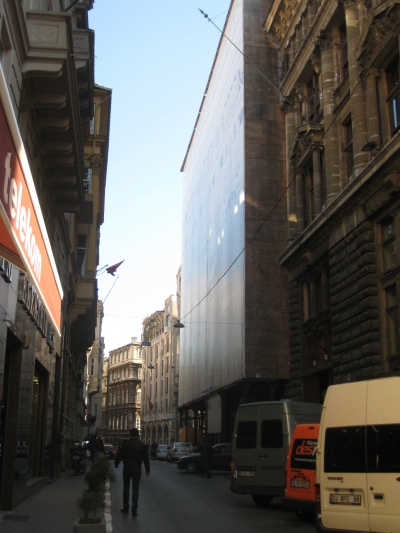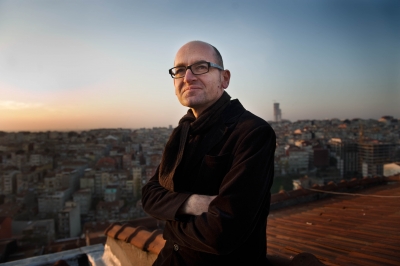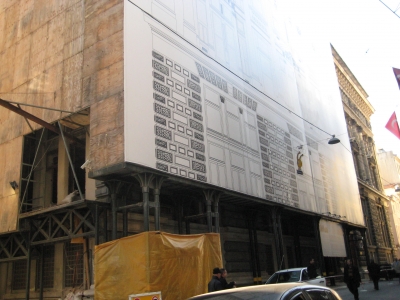Perhaps more than any other individual, Vasıf Kortun has redirected the trajectory of recent Turkish art history. As Chief Curator and Director of the 3rd Istanbul Biennial in 1992, Kortun completely changed the spirit of the event, shifting its focus from a national to an international one. By inviting artists from around the world to participate, Kortun facilitated the introduction of a great number of foreign artists to Turkey and of Turkish artists to the international community.
In addition to his groundbreaking curatorial work both within Turkey and abroad, he is also the founder and director of several contemporary art spaces in Istanbul that provided unprecedented research and exhibition resources to the Turkish art community and nurtured an entire generation of artists. This work began with ICAP Istanbul Contemporary Art Project (1998-2000) but was primarily conducted in the two institutions he opened in 2001, Proje4L Istanbul Contemporary Art Museum and the Platform Garanti Contemporary Art Center. In 2007, Kortun began work on a new, even larger institution, scheduled to open this April, whose details he discusses in this interview, to be published in two parts. Stay tuned tomorrow for the second half of this interview.
Elizabeth Wolfson: Let’s start at the beginning. Can you talk about your involvement with the Curatorial Studies program at Bard [College] in the 1990s?
Vasıf Kortun: Ah, the Curatorial Studies program. I started the museum there. And the library and all of that stuff. I was there for almost four years.
EW: This was in the ‘90s?
VK: ’93 to’97.
EW: Are you still involved with the college or the space?
VK: No, I was there for a couple of days last year giving a talk to a graduate class. On and off. But there’s no structural affiliation.
EW: What was that experience like, working with the college and founding that program?
VK: It was an interesting situation for me. I had never been in that situation before. There was no precedent, so you could do whatever you wanted. Or you could do anything you wanted in the sense that there was no index.
I thought it could be an experimental space, a big laboratory. That was my main position, figuring out how to move the institution from one place to another. And there was just the beginning of the first major curatorial generation, of people who are now in their forties and late forties. And none of them were in institutions at that time. And the American exhibition practice, especially institutional practice, was just absolutely awful. Extremely conservative, downright stupid, uninteresting. I mean there are always a few people doing interesting things, but overall really bad. So that was the idea, but it became kind of more corporate, after I left. It started doing regular exhibitions as if it could be in Manhattan. And then it moved again under Tom Eccles, it got more interesting.
But it was like a learning experience for me, testing things out in a genuine, almost naïve way.
EW: It seems like a lot of your work has been about testing out new ways of running art institutions and doing curatorial work.
VK: The opportunity that was presented, that kind of method space, that kind of way of working, the Bard program was quite right for that kind of thing. And we did well at the time. In 1996 we received the biggest review that the New York Times has probably ever written on an institution. And you don’t get space in the New York Times, there are a lot of institutions out there. So all of these things are great, you get kind of a context. It also allowed me to build a kind of network context with people who I thought were very interesting at the time, people I wanted to work with. So all of those things gelled at the time. And then I came back [to Istanbul].
But the Platform thing was also kind of chance, in a way.
EW: How do you mean?
VK: Chance in the sense that people were not ready for what we started to do when we did it. So that’s funny. That’s kind of interesting.
EW: You brought the revolution to the people.
VK: I didn’t bring anything. The artists were there. In terms of the community, the community existed. And was maturing. And had matured. In terms of public perception, in terms of funding, etcetera etcetera, there was no expectation on anyone’s part, for institutions like that. Because I started Proje4L and Platform at the same time.
EW: Oh I see. My impression was that Proje4L proceeded Platform.
VK: No, they opened within a day of each other.
EW: How were those two different from each other?
VK: Proje4L was this huge exhibition space at that time. because it was in Levent. At that time it was the biggest exhibition space in the city, by a very very large margin.
Proje4L was more about the exhibitions, the other one was much more about building the public, the archive, the library, and all of those things. That’s what the purpose was. When we started Platform it was very clear what we wanted to do. We would start with the exhibitions and then there would be the archive and the library and then the residency programs. And that’s what we did for six years, seven years.
EW: And Platform officially closed in 2007?
VK: We didn’t close it. Last year we still did programs, public programs, and we also did projects outside the country. We did a project at Artists Space in New York, another one in Münster, we did a lot of things outside of the country, I did some talks, that kind of stuff. But there is this preparation for the new situation. We checked out of exhibition practice in 2007. The most obviously visible thing was gone.
EW: It’s opening quite soon.
VK: April.
EW: So not in conjunction with the [2011 Istanbul] Biennial.
VK: One program, called SALT, which we will disclose on February 24 or 25. The name has been around for a while though.
EW: SALT, is that an acronym?
VK: In Turkish, it means just enough, simple, clear.
EW: I had only seen it in all caps, so I assumed it was an acronym.
VK: It is in all caps but it never exists by itself. You won’t say SALT most of the time. I mean, SALT does this, SALT does that, but there is no SALT. It always exists in a context. It always exists in a sentence. So it cannot exist like McDonald’s. It doesn’t exist as a corporate brand.
EW: What was the intent in changing the name? Was it because of the merging of so many different institutions?
VK: Yes. The idea was to close these three institutions, including Platform, Garanti Gallery, and Ottoman Bank Research and Archives and start a new institution. So this is not a continuation of the previous institutions, it is not about rolling three institutions into one. It is not about that. They have closed, and we are opening a new place. We really just have the resources of the previous institutions and the knowledge accumulated by the three institutions. But the future is not going to be limited by the history or the practice of the three institutions. That’s really not the point at all. We’re trying to something new, hopefully something much more agile. Even though the scale is… really big.
EW: Agility and scale.
VK: It can be done, I think. It’s never been tried.
EW: It seems like trying things that have never been done before is the essence of your work. All of your projects thus far have been of an extremely experimental nature.
VK: My position, our position, is that we don’t want to repeat everyone else’s mistakes. We don’t want to do what everyone else is doing. We know what we’re interested in. And we’re not afraid of failure. The only way to get something right is to fail. But the margin and room for failure has to be minimized. So we are looking to minimize this opportunity for failure through a succession of programs. We cannot have a grand failure. We can have a series of small failures.
But there are downsides to that. I means the institutions cannot be so mediatized, the way a blockbuster exhibition would be mediatized. But we still have a strong point in the sense that we have two buildings, one them is one this street [Istiklal Caddesi, a main thoroughfare in the Beyoğlu section of Istanbul].
EW: And where is the second one?
VK: The second one is down on the bank street [Voyvoda Caddesi], just before you get to the [ferry] boats, in a kind of palatial building that was the IMF of its time. A bank was founded to monitor the Ottoman debt structure by the robber barons. It was called the Imperial Ottoman Bank. So they built a huge building, the headquarters, and now we have the headquarters.

Street view down Voyvoda Caddesi of former Ottoman Bank Museum and Archives (on right, under construction)
EW: So will that space be the primary exhibition space, or will they happen in the space on Istiklal? What’s the division of labor?
VK: The Istiklal space is almost like an exhibition machine. It’s a tough building. It’s on Istiklal, I’m imagining it will circulate about 3,000-5,000 people per day. That’s how it’s built, that’s how it operates. That’s how we structured it. The entrance will be like a miniature Turbine Hall. A forum zone, a continuation of the street. Then two and half floors of exhibition, and then one floor of offices, and a walk in cinema. We call it a walk in cinema. A bookstore, a small café.
The other space has twice as much space. It has the auditorium. It’s a two hundred -something seater. There will several workshop spaces, where we can hold several workshops, we can host workshops. Then there’s a space called the Open Archive—because we’re sitting on several major archives, we’re doing a lot of archival work, producing a lot of research literature. So the Open Archive will work to problematize issues of the archive in an exhibitionary format. There will be a portion of the space will be devoted only to work on the archive, as a concept. And we have the library.
EW: What is the nature of this archive? What kinds of materials are there?
VK: I can give you the first two projects. One documents the work of Maryam Sahinyan, a female photographer who was working in Beyoğlu, in the same studio, for over forty years. Right here on Istiklal near Galatasaray. She had a place called Photo Galatasaray, her father was a studio photographer. So we’ve been digitizing, under the leadership of Tayfun Serttaş, an artist and archivist, for over a year now. It’s a huge project, like 200,000 photographs. Cleaning and digitizing and restoring.
So we’ll open with that. Then we’ll also have a project called Three Exhibitions, it’s basically the research from three projects from the early 1990s. One is from 1993, my show titled Memory/Recollection 2, and then there’s State, Misery, and Violence by Ali Akay from 1995, and then this project, Gar, from Ankara, that was closed a day after it opened, by local authorities.
It’s a complete reconstruction of these three projects, because there are a lot of things they have in common. One’s dealing with the memory of the Republic, state violence, and all of those things. One of them [State, Misery, and Violence] was not closed because it was up at the same time as the Biennial, mine lasted two weeks…
EW: It was closed by the state?
VK: We had to close it because we had a run in with a political party [that had been founded by the owners/renovators of the building, who wished to place a political banner on top of the exhibition banner]. And that was concerning.
EW: So you’ll be recreating these projects.
VK: Yeah. The installation shots, the reviews, what happened, original footage, all kinds of things. This is not only about the history of these exhibitions, it’s about the history of art in the region, the history of art over the past thirty years in Turkey.
Stay tuned tomorrow for Part 2 of this interview.






Pingback: Turkish and Other Delights | An Interview with Vasıf Kortun (Part II) | Art21 Blog
Pingback: Tweets that mention Turkish and Other Delights | An Interview with Vasıf Kortun (Part I) | Art21 Blog -- Topsy.com
Pingback: MFAH Listing of Events for April 11 - 17, 2013 | Houston News Online